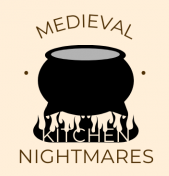Le Ménagier de Paris
This book was not written as a cookbook, although it does contain many recipes. It was written as a sort of guidebook to running a household. There are several surviving complete manuscripts of this text, which was written in the late 1300’s. The book is written in the voice of an aging wealthy husband to his young bride; the author is anonymous. This massive book contains advice on such topics as how to behave, how to dress, how to choose and care for servants and horses, and how to cook. The book contains more than 380 recipes, although several are not culinary recipes. There are also recipes for things like pest control poisons and invisible ink.
The English translation we will be using is named “The Good Wife’s Guide (Le Ménagier de Paris): A Medieval Household Book,” and was published in 2009. We are using three recipes from this book. The recipes we will be using are for poudre douce (sweet powder), a turnip dish, sweet tisane (barley water), and almond milk. The written recipes are as follows:
Poudre Douce: Hippocras. To make hippocras powder, pound together a quartern of very fine cinnamon, selected by tasting it, half a quartern of choice cassia buds, an ounce of hand-picked, fine white Mecca ginger, an ounce of grains of paradise, and a sixth of an ounce of nutmeg and galingale together. And nota that the powder and the sugar mixed together make “duke’s powder.” (Greco & Rose, 2009).
-Notes for this recipe: we will only make the Hippocras powder, not the Hippocras itself (a spiced wine). As this recipe notes, the powder, when mixed with sugar, makes “duke’s powder” (poudre douce).
Turnip Dish (unnamed): Turnips are firm and difficult to cook until they have been through the cold and frost. Cut off the head and tail and other whiskery rootlets or roots. After peeling them, wash in two or three changes of good, hot water; then cook them in steaming meat stock of either pork, beef, or mutton. Item, in Beauce after cooking them, they slice them up and fry them in a pan and sprinkle them with spices. (Greco & Rose, 2009).
-Notes for this recipe: we will be sprinkling poudre douce on the turnips after frying them in butter. They would likely have used a solid animal fat such as butter or lard in France rather than something like olive oil, which would have been more widely used further south.
Barley Water: Sweet tisane. Boil water, then for each septier of water add one generous bowl of barley—it doesn’t matter if it is all hulled—and two parisis’ worth of licorice; item, also figs. Boil until the barley bursts, then strain through two or three pieces of linen. Put plenty of rock sugar in each goblet. The barley that remains can be fed to poultry to fatten them. Nota that the youngest licorice is the best; when cut it is bright green, while the older is more faded and dead and dry. (Greco & Rose, 2009).
Almond Milk: Hazelnut beverage. Boil and peel the nuts, mix in cold water, then grind them and thin with boiled water and strain. Do this, grind and strain, twice. Then put in the cellar to cool; it is quite a bit better than a tisane. 302. Beverage of almond milk as above. (Greco & Rose, 2009)
-Notes for this recipe: we will substitute almonds for hazelnuts to create almond milk, as specified later in the recipe.
The premise of this book is very interesting; it is not written as a guide to the elite as other contemporary cookbooks are, and it is very detailed. The amount of work that goes into a manuscript, an illuminated one at that, is monumental. Manuscripts were very expensive in terms of time, money, and effort to produce. This book draws on content from Le Viandier, implying that the author was familiar with that work and borrowed from it in their own writings.
The sheer quantity of topics covered in this work, in my opinion, gives the reader a near-unprecedented look at life in middle-upper-class medieval France. There are so many hidden gems within this text for readers to discover.
Reference
Greco, G. L., & Rose, C. M. (2009). The Good Wife’s Guide (Le Ménagier de Paris): A Medieval Household Book. Cornell University Press.
